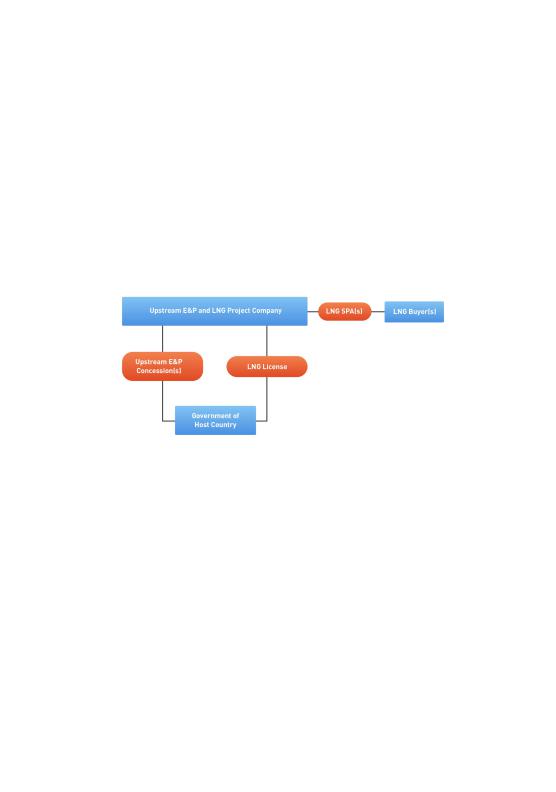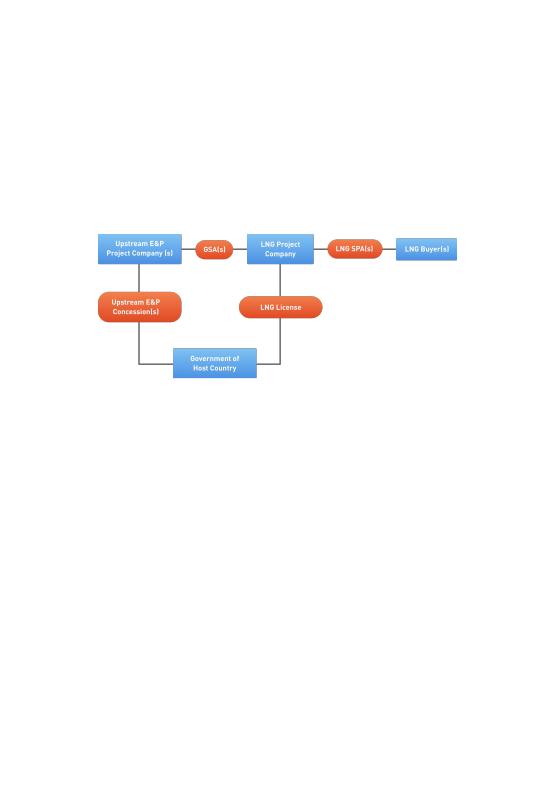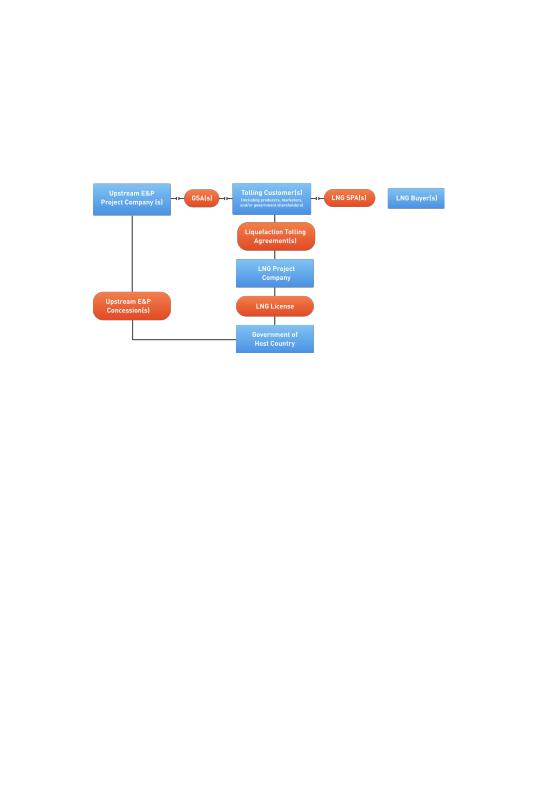
01 POWER ISLAND / 01 CCPP / DOE__Understanding Natural Gas and Lng Options October 11 2017_1
.pdf
STRUCTURING AN LNG PROJECT
Because the owner of the upstream exploration and production project is the same entity as the owner of the LNG liquefaction and export project, there is typically no other user of the LNG liquefaction and export project. The credit of the LNG buyer or buyers provides the financial underpinning for both the upstream exploration and production project and the LNG liquefaction and export project.
Examples of integrated project structures include Qatar's Qatargas and RasGas projects, Russia's Sakhalin Island, Norway's Snohvit, Australia's Northwest Shelf and Darwin LNG, and Indonesia's Tangguh.
The below diagram describes the integrated commercial structure for LNG liquefaction and export projects.
Merchant Structure
Under the merchant commercial structure, the producer of natural gas is a different entity than the owner of the LNG export facilities, and the LNG liquefaction project company purchases natural gas from the upstream exploration and production project company under a long-term natural gas sale and purchase agreement. The upstream exploration and production project revenues are derived from the sale of natural gas to the LNG liquefaction project company. The LNG liquefaction project profits, in turn, are derived from the amount by which the revenues from LNG sales exceed the sum of the cost of liquefaction (including debt service) and natural gas procurement costs. Because the owner of the upstream exploration and production project is a different entity than the owner of the LNG liquefaction and export project, there may be more than one supplier of natural gas to the LNG liquefaction project company.
56

STRUCTURING AN LNG PROJECT
The credit of both the LNG buyer or buyers and the natural gas producer or producers provides the financial underpinning for the LNG liquefaction and export project.
Merchant structure examples include Trinidad trains 1, 2, and 3, Angola, Nigeria, Equatorial Guinea, and Malaysia.
The merchant commercial structure for LNG liquefaction and export projects is illustrated in the diagram below.
Tolling Structure
Under the tolling commercial structure - the owner of natural gas, whether a producer, aggregator or buyer of natural gas - is a different entity than the owner of the LNG export facilities. The LNG liquefaction project company provides liquefaction services (without taking title to the natural gas or LNG) under one or more long term liquefaction tolling agreements. The LNG liquefaction project revenues are derived from tariff payments paid by the terminal's customers. The payments typically take the form of a two-part tariff. Fixed monthly payments cover the project company's fixed operation and maintenance costs, debt servicing, and return on equity. Cargo payments are designed to cover the project company's variable costs, such as power. Because the functions of the LNG liquefaction project company do not include a commodity merchant function, the LNG liquefaction project company does not bear commodity merchant risks such as the supply, demand, and cost of natural gas and LNG. The credit of the tolling customer or customers provides the financial underpinning for the LNG liquefaction and export project.
57

STRUCTURING AN LNG PROJECT
Tolling structure examples include Trinidad's train 4, Egypt's Damietta, Indonesia's Bontang, and the U.S.' Freeport LNG, Cameron LNG, and Cove Point facilities.
The tolling commercial structure as applied to LNG liquefaction and export projects may be illustrated as follows:
Hybrid Structures
Hybrid structures combining some of the attributes of integrated, merchant, and tolling models may be used to tailor LNG liquefaction and export projects to the characteristics and needs of particular host governments and project participants. For example, hybrid merchant-tolling structures have been used in the U.S. by Cheniere's Sabine Pass and Corpus Christi projects. Here, the project companies provide a marketing service to acquire natural gas and actually take title to the natural gas and sell the LNG to the customer, but also receive fixed monthly reservation charges regardless of whether their customers take LNG.
58

STRUCTURING AN LNG PROJECT
The below table lists some advantages and disadvantages of the different commercial structures.
Commercial |
Advantages |
Disadvantages |
|
Structure |
|
|
|
|
|
|
|
Integrated |
Commercial parties are |
Does not allow for different upstream projects |
|
|
aligned between the |
with different ownership to come together in one |
|
|
upstream and LNG |
LNG project |
|
|
liquefaction project |
Does not allow for other entities, including the |
|
|
No need to determine a |
host government, to also have ownership in the |
|
|
transfer price |
plant |
|
|
|
Complex to expand for non-concession |
|
|
|
production |
|
|
|
|
|
Merchant |
Known and commonly |
Requires additional project agreements with |
|
|
used structure familiar with |
government |
|
|
buyers and lenders |
Potentially different fiscal and tax regime |
|
|
Flexibility to allow non- |
Requires negotiation of gas transfer price |
|
|
concession investors in the |
|
|
|
LNG plant |
|
|
|
|
|
|
Tolling |
Known and commonly |
Requires additional project agreements with |
|
|
used structure familiar with |
government |
|
|
buyers and lenders |
Potentially different fiscal and tax regime |
|
|
No price or market risk for |
|
|
|
the LNG project investor |
|
|
|
|
|
|
Government |
Owner (government) has |
Government may lack experience in developing, |
|
Owned |
full control |
marketing and operating LNG |
|
|
|
|
|
59

STRUCTURING AN LNG PROJECT
Driving Factors on Choice of Structure
There are a number of key driving factors that influence the choice of an LNG project structure for the host government, the investors, the LNG buyer(s), the project lenders and the other project stakeholders. Some of these key driving factors include:
>Legal Regime and Taxes: The host country's legal regime and local taxes often have a major impact on project structure. An LNG project may not be considered as a part of the upstream legal regime in the host country and therefore will need to comply with another legal regime, e.g. general corporate regime, special mid-stream regime or downstream regime. Additionally, the tax rate for the upstream regime may be different (higher or lower) than the legal regime for the LNG project. Both of these factors are considered in selecting a structure.
>Governance: The typical upstream venture is an unincorporated joint venture with the external oversight provided by the host country regulator and internal 'governance' provided through an operating committee to the operator, who is generally one of the upstream parties. Day-to-day governance and oversight tend to be less rigid and controlled when compared to an incorporated venture. The government, local stakeholders, lenders and the LNG buyers may desire to have a more direct say in internal project governance and decision making. This needs to be reflected in the structure selected. A poorly governed structure can lead to conflicts among the parties and impact the efficiency and reliability of the LNG Project.
>Efficient Use of Project Facilities: The LNG project structure should encourage efficient use of all project facilities, by the project owners and by third parties. The structure should encourage sharing of common facilities, open access to third parties for spare capacity and reduction of unnecessary facilities and their related costs, thereby making the project more profitable for all stakeholders.
60

STRUCTURING AN LNG PROJECT
>Flexibility in Ownership: There may be a desire by the government, other local stakeholders, LNG buyers or lenders (e.g. the International Finance Corporation) to have a direct ownership interest in all or specified portions of the LNG project. Alternately, some of the upstream investors may not be interested in owning the liquefaction portion of the LNG project. The choice of a particular structure can enable different levels of ownership in the different components of the LNG project.
>Flexibility for Expansion: A chosen structure may discourage or enable maximum use of common facilities and future expansion trains. For example, an integrated project structure is more difficult to expand if new production comes from third party gas resources than would be the case with a merchant project or a tolling project. If at some point the upstream does not have enough gas, it may be more difficult to integrate another player with a different gas production model or a different IOC into an integrated project.
>Desire for Limited Recourse Financing: If the LNG project is going to try to attract limited recourse project financing, a special purpose corporate entity must generally be set up as the finance partner. It is harder to get this sort of project financing with an unincorporated joint venture structure. Consequently, an LNG project looking for financing will typically have a separate corporate structure for the full LNG project or at least for the financing aspect of the LNG project.
>Operational Efficiencies: The integrated structure offers operational efficiencies because only one operator is involved in construction activities. The operational inefficiencies of having two operators can be overcome through transparency and coordination between the operators. Separate projects can lead to project-on-project risk i.e. where one project is ready before the other.
>Marketing Arrangements: The marketer of the produced LNG can be different from the producer, depending on the LNG project structure. The issue is whether there is individual marketing by an investor of its share of LNG production or whether LNG is marketed by a separate corporate entity.
61

STRUCTURING AN LNG PROJECT
>Regulations: The choice of project structure will affect the required regulations.
>Gas Transfer Price: The gas transfer price is the price of gas being sold by the upstream gas producer to the LNG plant in a merchant structure. This is often a contentious issue, since the major sponsors of the LNG project need to negotiate benefit sharing with the upstream
gas producer. In many cases, each segment of the gas value chain may fall under a different fiscal regime. The overall profit of the sponsor may then be maximized by selectively determining where the economic value is to be harvested. When the gas is moved from the upstream (production) to the downstream (e.g. LNG) sector, an “arm's length” price may be difficult to negotiate. For example, the natural gas production phase of the project may be subject to an upstream fiscal regime which in many countries includes a high tax rate (Petroleum Profit Tax or equivalent). The transportation segment, such as a gas pipeline or conversion of the natural gas to other products such as methanol, usually does not fall under the high tax regime.
62

STRUCTURING AN LNG PROJECT
Import Project Structures
LNG import projects typically follow the same major project structures utilized with LNG export projects, namely integrated, merchant and tolling. In this context, it should be noted that the LNG import terminal itself, whether land-based or floating, can be owned by the LNG import project or leased, often through a tolling mechanism.
>Integrated Structure: the integrated import structure entails the upstream and liquefaction owners extending their reach into the gas market by including a regas terminal. This allows the upstream owners who produce the gas to sell their regasified LNG as gas in a distant market. Examples include the U.K.'s South Hook LNG receiving terminal, Italy's Adriatic receiving terminal and a number of Japanese and Korean receiving terminals.
>Tolling Structure: in the tolling structure the import terminal provides services, including offloading, storage, and regasification, and charges a fee for such services. Examples include the U.S. and Canadian import terminals, and Belgium's Zeebrugge import terminal.
>Merchant Structure: here the owner of the import project buys LNG and sells natural gas, earning a profit on the difference between the price of the LNG and the costs of the import terminal. This structure is exemplified by the various Japanese terminals serving the Japanese utilities.
These structures are discussed in more detail in the chapter on LNG Import Projects.
63

Government
Role
Introduction
Gas Policy and Regulatory Framework
Legislation and Fiscal Regime
Institutional Framework
Stakeholder Participation
Government Participation
Roles of Regulator

GOVERNMENT ROLE
Introduction
In general, the government's role is to set policies that define development objectives for the gas sector, establish institutions that set priorities, establish legal and fiscal frameworks governing gas and LNG development, and monitor governmental entities and private sector partners to ensure the rules and priorities are followed by all parties during development and operation of infrastructure projects. In some countries, projects are developed and operated by state oil companies, but, typically, LNG projects, whether they are developed by national or foreign investors, require access to specialized knowledge. In some cases, governments also directly participate in developing strategic projects.
Rules, regulations, and procedures should be established, sometimes through the implementation or amendment of legislation or other agreements that have the broad approval of government authorities and its diverse constituencies/stakeholders. Rules, regulations, and procedures should be clear, consistent, and transparent so that all stakeholders know what to expect from each other. Since it is expensive and difficult to store gas in strategic quantities, plans should also be in place to utilize gas received under domestic supply allocations to promote the development of power and other industrial projects.
65
